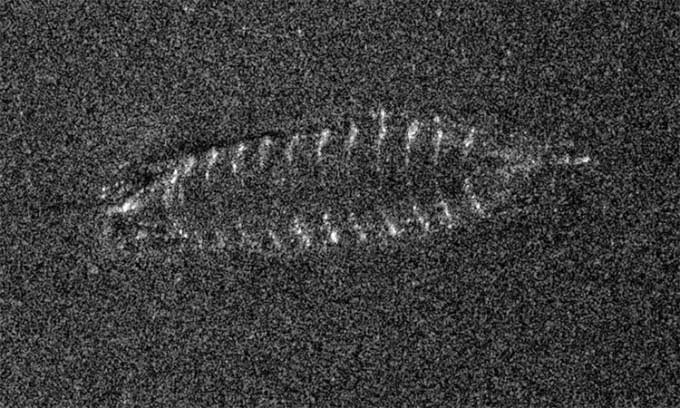Located approximately 410 meters below the surface of a freshwater lake, the wooden remains of the ship, measuring about 10 meters in length, are well-preserved.

Sonar image from an underwater autonomous vehicle shows the wooden frame shape of the 700-year-old ship. (Photo: FFI/NTNU)
The Norwegian Defence Research Establishment (FFI) announced the discovery of a 700-year-old shipwreck at the bottom of Lake Mjosa, Norway’s largest lake with a volume of 56 km3 of water, as reported by Smithsonian on November 28. Lake Mjosa has been a busy trade route since at least the Viking Age, but from 1940 to 1970, it became a dumping ground for surplus munitions. Currently, scientists are mapping the lake’s bottom to locate munitions while hoping to uncover even older artifacts.
After analyzing sonar images (a technique for underwater location using sound waves), archaeologists believe the ship is made of wood and is approximately 10 meters long. It rests at a depth of 410 meters underwater. Despite the images being somewhat unclear, the research team was able to identify the ship’s stern and estimate that it was built after the 1300s. Prior to that, shipyards primarily produced Viking ships with nearly identical ends. After the 1300s, ships typically featured distinct bows and sterns.
Based on the sonar images, the archaeological team believes the builders used a Nordic technique of overlapping planks for the hull to make the ship lighter. Experts also suggest it had a central rudder, whereas Viking ships usually had their rudders on the right side of the hull. The ship may have been equipped with a single mast and a square sail, similar to Viking vessels.
“Mjosa is a freshwater lake, so the wooden remains of the ship are well preserved. Metal may rust, and the ship could lose its structure, but the wood remains intact. A similar ship would not last more than a few decades if it sank offshore. Therefore, if you want to find sunken Viking ships in Norway, Mjosa is probably the most promising place,” said Oyvind Odegard, a marine archaeologist at the Norwegian University of Science and Technology.
To date, scientists have not been able to use cameras to observe the shipwreck more clearly due to bad weather and limited visibility. They hope to conduct more detailed research next year.




















































